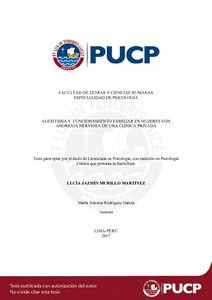Alexitimia y funcionamiento familiar en mujeres con anorexia nerviosa de una clínica privada
Abstract
La presente investigación tuvo como objetivo explorar si existe relación entre el
funcionamiento familiar de pacientes con anorexia nerviosa y sus síntomas alexitimicos.
Para este propósito se contó con la participación de 37 pacientes mujeres de una clínica
privada de Lima diagnosticadas con anorexia nerviosa según criterios del CIE-10, cuyo
rangos de edad oscilaban entre los 18 y 30 años (M = 20.14, DE = 2.43). Los
instrumentos usados fueron el FACES III que mide funcionamiento familiar, validado
en nuestro contexto por Reusche (1994), y la adaptación lingüística del TAS-20
realizada por Romero (2009) el cual mide síntomas de alexitimia. Como resultado, se
encontró que existe una relación entre el funcionamiento familiar reportado por las
pacientes y sus síntomas alexitimicos, hallando que una baja cohesión estaría
relacionado con la dificultad para identificar y describir sus emociones. Asimismo, se
encontró que las pacientes que percibían a sus familias con mayor disfuncionalidad
presentaban mayor dificultad para identificar y describir sus emociones. En este marco,
se concluyó que la disfuncionalidad familiar percibida por la paciente estaría vinculado
con sus síntomas alexitimicos. This research aimed to explore whether there is an association between family
functioning and symptoms of alexithymia in patients diagnosed with Anorexia Nervosa.
Thirty-seven female patients of a private clinic in Lima diagnosed with Anorexia
Nervosa according to ICD-10 criteria were recruited. Ages ranged between 18 and 30
years (M = 20.14, SD = 2.43). Two questionnaires were used, the FACES III, validated
in our context by Reusche (1994) to measure family functioning, and the linguistic
adaptation of TAS-20 by Romero (2009) to measure alexithymia. Overall, there is a
relationship between family functioning reported by the patients and their alexithymic
symptoms. Specifically, low cohesion is related to difficulty in identifying and
describing emotions. Moreover, patients who perceived greater dysfunctionality in their
families had greater difficulty in identifying and describing their emotions. In
conclusion, the family dysfunction perceived by the patient is related to the alexithymic
symptoms.
Temas
Alexitimia
Anorexia nerviosa
Mujeres--Relaciones familiares
Anorexia nerviosa
Mujeres--Relaciones familiares
Para optar el título de
Licenciado en Psicología Clínica
Collections
The following license files are associated with this item:






